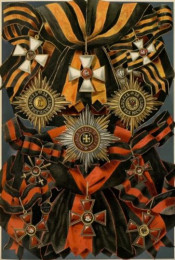
The Presidential Library’s webinar dedicated to the highest military award of the Russian Empire
The thematic webinar “The Establishment of the Order of St. George the Victorious” was held at the Presidential Library. The event was attended by specialists and users of numerous remote access centers located both in Russia and abroad. The webinar recording is available on the institution’s YouTube channel.
Yevgeny Yurkevich, senior researcher at the Military Historical Museum of Artillery, Engineers and Signal Corps, noted that the Order of St. George the Victorious was a unique phenomenon in the world award system: “In addition to the signs for wearing, he also had such serious additions as the St. George’s banners, St. George standards and even St. George military units. These elements were not in any military order of the world".
During the informational and methodological webinar from the electronic collections of the Presidential Library, the specialist presented not only a review of materials devoted to the highest military award of the Russian Empire, but also demonstrated rare sources about St. George himself. Among them are the Old Believer manuscript “The Life and Canon of St. George the Great Martyr” of the XIX century, the publication “The Life of the Holy Great Martyr and Victorious George: in Russian and Karelian Languages” of the beginning of the XX century and others.
The Order of St. George was established by Catherine II on November 26, 1769, a year after the outbreak of the Russo-Turkish War of 1768–1774. For the first time in Russia, the order was divided into 4 degrees and was intended to be awarded solely for distinction in military exploits. The empress gave a very short exemplary instruction, for which she should be awarded this order: “Neither the high status, nor the wounds received before the enemy, give the right to be granted this order: but it is given to those who not only corrected their position in all by oath, honor and my duty, but moreover, they still distinguished themselves by a special courageous deed, or they gave us wise and useful advice for our military service. <...> This order should never be removed: for it is acquired by its merits”.
In 1807 the “Insignia of the Military Order" was established for the lower ranks ranked as the Order of St. George. The silver cross will later take on the unofficial name of "soldier George". The orders were not numbered, but lists of awarded heroes of all military ranks were kept.
In the electronic collections of the Presidential Library present "Album of the Knights of the Order of St. Great Martyr and Victorious George and St. George’s weapons, among which are the names of Admiral A. V. Kolchak and Baron P. N. Wrangel. The publication "List of lower ranks - St. George cavaliers of the Guards crew since its formation in 1810" lists the names and sometimes the names of sailors, privates and other ranks, indicating insignia and for which they were granted.
Unique digitized publications with descriptions of feats are of much interest, for example: “The great hero, 14-year-old St. George cavalier Kolya Zuev, who risked his life, made a series of bold attacks and was thrice awarded the highest awards - St. George’s Crosses of II, III and IV degrees” (1905), “The exploits of non-commissioned officer A. N. Volkov, holder of five St. George’s crosses” (1914) and others.
Orders were awarded not only to individual heroes, but also to entire military units. Thus, from the publication “Schedule of units of guard troops, showing seniority and insignia that should be assigned to them” (1886), you can find out that “the Life Guards of the Preobrazhensky Regiment should be assigned the regiment banner of Georgievsky with the inscriptions: “For the accomplished feats in the battle of August 17, 1813 at Kulm ", " ..., with the St. Andrew’s anniversary ribbon".
The Order of St. George the Victorious was abolished after the October Revolution of 1917, and then reinstated by decree of the President of Russia № 1463 of August 8, 2000 as a military award of Russia with the preservation of external signs and changes in the statute.
A large number of materials in the collections of the Presidential Library are devoted to this issue:
• “The Order of Consecration of the Signs of the Order of the Holy Great Martyr and Victorious George” (not earlier than 1769);
• Decree of Nicholas I “On the Order of the Holy Great Martyr and Victorious George” (1833, new statute);
• archival affairs:
-“On the Knights of the Order of St. George and persons with golden weapons with the inscription "for courage", who are in the service of the State Chancellery "(1876),
- “On the meetings of cavalier doom in orders: St. St. George Vladimir and St. Anna and the invitation to these meetings of all the gentlemen, consisting of members of the State Council and ranks of the State Chancellery” (1835) and many others.
The listed rarities are presented in the electronic reading room of the Presidential Library, some of which are available on the institution’s portal. The materials are provided in any of the centers of remote access to the resources of the national electronic repository located throughout Russia and abroad.

